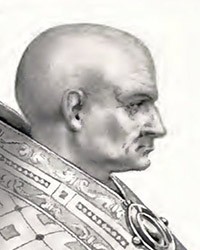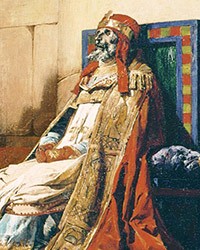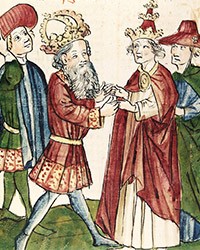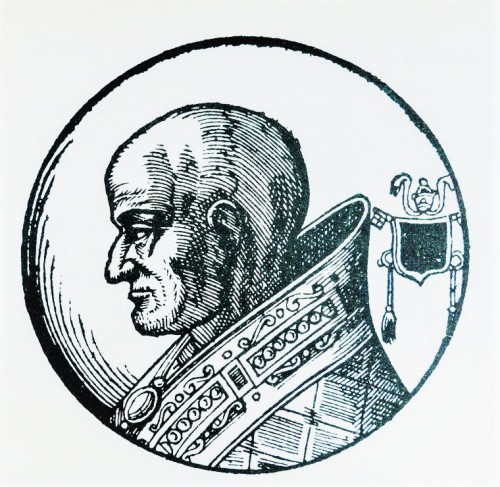
Pope Sergius III, Le vite dei pontifici, 1710, Bartolomeo Platina
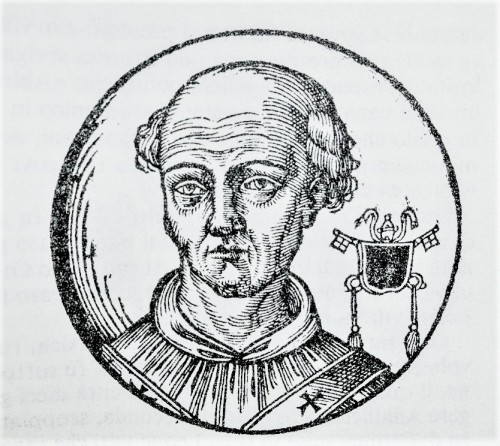
Pope John XII, Le vite dei pontifici, 1710, Bartolomeo Platina
This term, which was invented in the XVIII century by an English historian of the Renaissance, Edward Gibbon, has its roots in two Greek words: porne – harlotry and kratos – rule. It has been commonly used to describe the relations in place in Rome during the first half of the X century, which were characterized by, as the name itself would suggest, the domination of spoiled harlots. This definition, still today used in scientific works, is both unjust as well as useless and proves how propaganda repeated for centuries can cloud our perception of history.
This term, which was invented in the XVIII century by an English historian of the Renaissance, Edward Gibbon, has its roots in two Greek words: porne – harlotry and kratos – rule. It has been commonly used to describe the relations in place in Rome during the first half of the X century, which were characterized by, as the name itself would suggest, the domination of spoiled harlots. This definition, still today used in scientific works, is both unjust as well as useless and proves how propaganda repeated for centuries can cloud our perception of history.
We learn about “the rule of harlots” for the first time through a chronicler working at the court of Emperor Otto I – Liutprand of Cremona (920-972). Driven by the particular interests of his protector, he described in this way, the rule of women from the Tusculum family (Theodora the Elder, Marozia, Theodora the Younger), who using their seductive talents, controlled the men (including popes) in Rome from the year 904 to 964 (from the pontificate of Sergius III until the death of John XII). Subsequent chroniclers copied this opinion, including those connected with the monks from the Cluny monastery, who preached moral renewal, while it was grounded at the beginning of the XVII century by the confessor of Pope Clement VIII – Cardinal Caesar Baronius (Church Chronicles), the author of another, equally popular term to describe those times – “the age of wickedness” (saeculum obscurum). Then it only became worse, since the image of these sinful women and immoral popes fit very well with the Protestant criticism of the Catholic Church. In this way in European historiography an image of the X century was created, in which woefully shameful things occurred, and still today we are convinced that it was the darkest period in the history of the papacy, which is even more infamous than the rule of the Borgia pope (Alexander VI). However, was this really the case? Let us give the floor to Liutprand of Cremona who writes thus: “A certain shameless whore known as Theodora was at a point in time the only monarch in Rome and it is even a shame to utter these words! – she ruled in the most manly way possible. She had two daughters, Marozia and Theodora, and these two harlots not only equaled her, but even surpassed her in deeds which are the domain of Venus”. The zealous Baronius, following in the footsteps of his predecessor described them in the following way: “The vain Messalinas, filled with desires of the flesh and skilled in all forms of wickedness ruled Rome and prostituted the throne of St. Peter for their brothers and lovers”. Both texts essentially say the same thing, but not completely. While Liutprand of Cremona underlines “manly” rule achieved by the women from the Tusculum family through their “shameless” behavior, Baronius accuses them of prostituting the popes. The first wanted to humiliate the insubordinate Roman aristocrats, who objected to Otto I (for instance in the selection of popes), suggesting than in an unmanly way they let themselves be led around by their noses. Baronius on the other hand, refers to the “diabolical” corporeal qualities of these women, with which they seduced, so to speak, the innocent vicars of Christ. One is trying to influence the manly ego of the Romans, the other in a way justifies the weak-willed popes.
Unfortunately, we do not possess enough sources on those times, which would provide us with the proper foundation to defend the three aforementioned women, however we can describe them based on the historical background of those times, leaving off to the side the imputed desires, wickedness and Venus-like tricks. It is worth adding, that at that time the role of the emperor as the protector of Patrimonium Sancti Petri, for which the idea came about at the beginning of the IX century along with the coronation of Charlemagne, was no longer in force. The Carolingian Empire experienced internal problems, while popes became more and more dependent on wealthy Roman families. The bishops of Rome sometimes desired to free themselves from this aristocratic “grip”, while sometimes just the opposite – in collaboration (from time to time forced) saw benefits. The criticized aristocrats, sometimes of great status (Alberic II) obtained profits from papal rule, but also supported it, for example by pious foundations. Let us look in this context, at the aforementioned heroines of this inglorious pornocracy, who as it will turn out had little to do with prostitution.
Theodora the Elder was the wife of an influential aristocrat Theophylact I of Tusculum, who from the beginning of the X century for over a quarter century was the de facto ruler of Rome. We know very little about her, except the fact that she was responsible for placing upon St. Peter’s throne (according to Liutprand of Cremona), her lover Sergius III. However, it is doubtful if this was truly her doing. The pope, who himself came from the Tusculum family, fit very well with the particular politics of Theophylact. Another pope who was once again “placed” on the throne thanks to Theodora’s seductive charms (again according to Liutprand), was John X, but once again – apart from suppositions – there is no evidence to prove this.
Let us now move to her daughter, Marozia, accused of harlotry. In her early teenage years the girl was supposed to, convinced by her mother, have sexual relations with Pope Sergius III, while the fruit of this relationship was to be her firstborn son. However, the French chronicler active during those times, Flodoard of Reims in his Annales decisively denies those claims. The role of Marozia, was indeed significant in Rome, after the death of her father Theophylact (925?). Due to a lack of male heirs, it was she and her husband who were responsible for strengthening the position of the family within the city. It is true that she placed her son (John XI) upon St. Peter’s throne, while her alleged fault for the death of one of his predecessors (John X), fit perfectly with the political strategy of the family, for which an insubordinate pope was an obstacle. At time when murder, assassination and brutal dealing with adversaries was practiced on a daily basis, Marozia did not differ greatly, apart from the fact that she was a woman. Her sister Theodora the Younger, remains completely unknown to us and if it were not for the information provided by Liutprand of Cremona, that Marozia’s son, Alberic II, wanting to take over power and overthrow his mother, entered the city, shouting that it is time to put an end to the rule of “harlots” (Marozia and Theodora the Younger?) we would know even less about her, besides the fact that she was married to an influential Roman aristocrat from the Crescentii family.
Alberic II, successfully continued the politics of controlling the city – he declared himself a duke of Rome and placed four popes on St. Peter’s throne, while at the end of his life forced his son (John XII) upon it. Surprisingly enough, his figure is not an object of criticism. On the other hand his son, John XII most definitely is, being attributed by Liutprand a whole slew of every evil imaginable. We may ask ourselves, why did the imperial chronicler focus his attention upon him. Let us not forget, that the papal court at that time did not differ greatly from contemporary Italian courts of dukes (both earlier and later). Adultery, perjury, bribes, and perfidy all occurred, while celibacy was a matter of choice, practiced by only a few of the popes. However, Emperor Otto I, based on these very crimes, took away the papal tiara from John XII and desired to discredit him in a special way. Why? First of all, the pope did not abide by the rules, which the emperor had wanted to introduce in relations between the papacy and the empire, secondly, in inheriting the rule of Rome from his father, he did not want to resign from this post. Otto looked upon this as an obvious insubordination. The position of the emperor from the Ludolfinger family was not well-grounded on the Apennine Peninsula, therefore, it was necessary to create a clear message, in which the emperor was the symbol of good, strength, morality, and manly virtues, while the symbol of evil were the corrupt and morally fallen aristocrats and popes. And this is where the chronicler Liutprand of Cremona came in very handy. His chronicle is filled with contempt for the family which had for half a century held power in Rome, and especially for women of this family. The vulgar and misogynic way of describing the grandmother and great-grandmother of Pope John XII had a specific propaganda goal. What is it that the clever imperial courtier is trying to tell us in his Historia Ottonis? In brief it is this: Romans, be ashamed of the corrupt and promiscuous popes and powerless men, ruled by lustful and shameless women. In allowing their rule you have lost your strength and vigor. It is time for a change, which will be brought about by the rule of an emperor from the North (Otto I), who shall cleanse this Augean Stable of harlotry and restore the proper status of men in Italy.
We can only assume that if at that time Liutprand of Cremona had worked for the papal court and the Tusculum family, the story we would be telling today could be very different, while Theodora could – as the grandmother and great-grandmother of pope, similarly to her daughter Marozia (mother and grandmother of a pope) – be in position of respect similar to Roman matrons. However, in a situation where our knowledge is based on such biased and one-sided sources, as those concerning the period in question, we are powerless – they will always come out victorious, despite being poisoned with the venom of propaganda.








